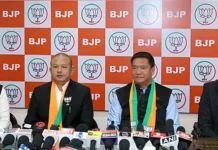Monday Musing
[ Taba Ajum ]
Recently, when a report of the Chinese constructing a new village in Upper Subansiri district of Arunachal made headlines in the national media, it created a lot of confusion among the people of the state. NDTV was the first to report it, claiming that 101 houses had been constructed, and that it had been confirmed by satellite images. Soon a picture of newly constructed houses started making the rounds on social media. Then a political slugfest started with the Congress raising uncomfortable questions. The BJP, led by union minister and MP from Arunachal, Kiren Rijiju, hit back, accusing the Congress of failing to protect the territory, including the area where the new village has reportedly come up, when the Congress was in power. MP Tapir Gao, who has been raising concern over Chinese incursion into the state, also blamed the previous Congress regime for the Upper Subansiri incident.
In the political battle, the real issue got lost somewhere. According to sources, the place where the new village has come up is inside the Indian side of the McMahon Line and it used to be governed by India in the past. The new village has reportedly been settled near the Tsari Chu river, also known as Lensi in the local language. The area is located in between Longju and Bisa in Upper Subansiri district, and is now reportedly under Chinese control. Longju had a CRPF camp and was under the Indian government till 1959, when it was captured by China. The Bisa area fell to the Chinese in 1987.
“The village is definitely on the Indian side of the McMahon Line but has been under Chinese occupation since 1987. Further, China does not recognize the McMahon Line, which was the accepted boundary between British India and Tibet, agreed in 1914,” the sources said.
While the people of Arunachal have reacted strongly to the Chinese move to construct a village inside the McMahon Line, the government of India, considering its stoic silence, seems to have given up territorial claim over Bisa and Longju. This has been a problem across the India-China border, especially in Arunachal, Sikkim and Ladakh. In these regions, the local tribal people who have inhabited the areas since ages are well aware of the topography. The people know the boundary because for many generations their grandparents have hunted there, and they have been living in these mountains and always believed the area as their own. However, the government of India sees through a political perspective.
It is aware that it may not be practically possible to redraw the boundary as it knows that China will never accept a boundary based on the McMahon Line.
A similar thing happened in Ladakh before the Galway valley incident. At that time too, many local leaders had claimed that the Chinese had been intruding into Indian land for years, and that they had raised red flags with the authorities at all levels – from the Ladakh Autonomous Hill Development Council, which governs the region, to BJP MP from Ladakh, Jamyang Tsering Namgyal, and even the central government. Their concerns and red flags, they added, were ignored time and again. In the recent past in Arunachal, incidents of Chinese incursion have been reported from Andrella Pass in Dibang Valley, Chaglagam (Anjaw), etc. BJP MP Tapir Gao himself on the floor of the Lok Sabha had made a startling claim in November 2019 that China had encroached 50-60 kms into the state. He had raised serious concern over Chinese activities in the Taksing area of Upper Subansiri. At that time the central government dismissed his claim.
There is a huge difference between the perspective of the local people and those governing sitting in AC rooms in South Block in Delhi. In the interest of the nation, the government of India should encourage more settlement near the borders. Also, unnecessary restrictions put on the movement of local people along the India-China border should be lifted. The border should be made accessible to the local people. This is one among many methods to counter the nefarious designs of China.




